Dense clouds create a mystical jungle filled with lush vegetation. If it wasn’t for the persistent rain, the cloud forests in Costa Rica would be a great place to trek.
Cloud Forests
We’ve trekked in countless jungles all over the world but have never visited a cloud forest. The highlands in Costa Rica seemed like the perfect place to visit our first one. The cloud forests straddle the Continental Divide which is at 1,500 m (4,921 feet) of elevation. Warm, moist air blows in from the Pacific on one side and the Caribbean on the other. As the air rises in the mountains it cools, forming clouds. From the distance you can see a layer of dense clouds hanging low over the mountain tops.

View of cloud forests over the mountains, Costa RIca 
View of cloud forests over the mountains, Costa RIca
There are two cloud forests near the neighbouring towns of Santa Elena and Monteverde. We chose to visit Santa Elena Cloud Forest Reserve as it is more natural and has fewer tourists than Monetverde Cloud Forest Reserve. Inside the reserve hiking trails range from ½ km to 5 km loops. The shorter trails are paved, but the longer ones are natural. This is what we thought we wanted however, natural in a cloud forest means wet and muddy.
When we first arrived, moisture was dropping down on us from the saturated trees above. It was a nice, peaceful walk through the dense, misty jungle. The interesting thing about cloud forests is the vegetation. This jungle was more overgrown than anything we had seen. Trees were plastered in moss, lichen, ferns, vines and flowers. It was difficult to see the trees’ bark because they were covered in other vegetation. Even benches were covered in thick moss.
The problem with hiking in a cloud forest is that there are no panoramic views. We hiked up to a viewpoint, but all we saw was the inside of a cloud.

Dense vegetation, Santa Elena Cloud Forest Reserve 
Dense jungle, Santa Elena Cloud Forest Reserve 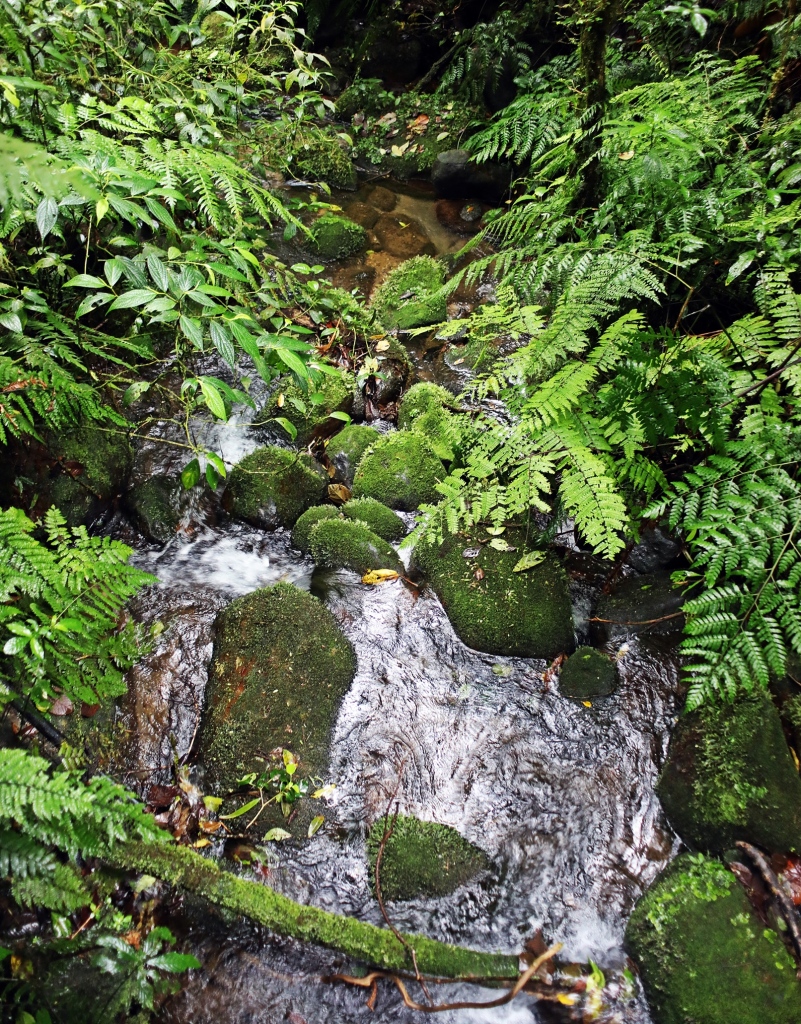
Mossy creek, Santa Elena Cloud Forest Reserve 
Dense vegetation, Santa Elena Cloud Forest Reserve 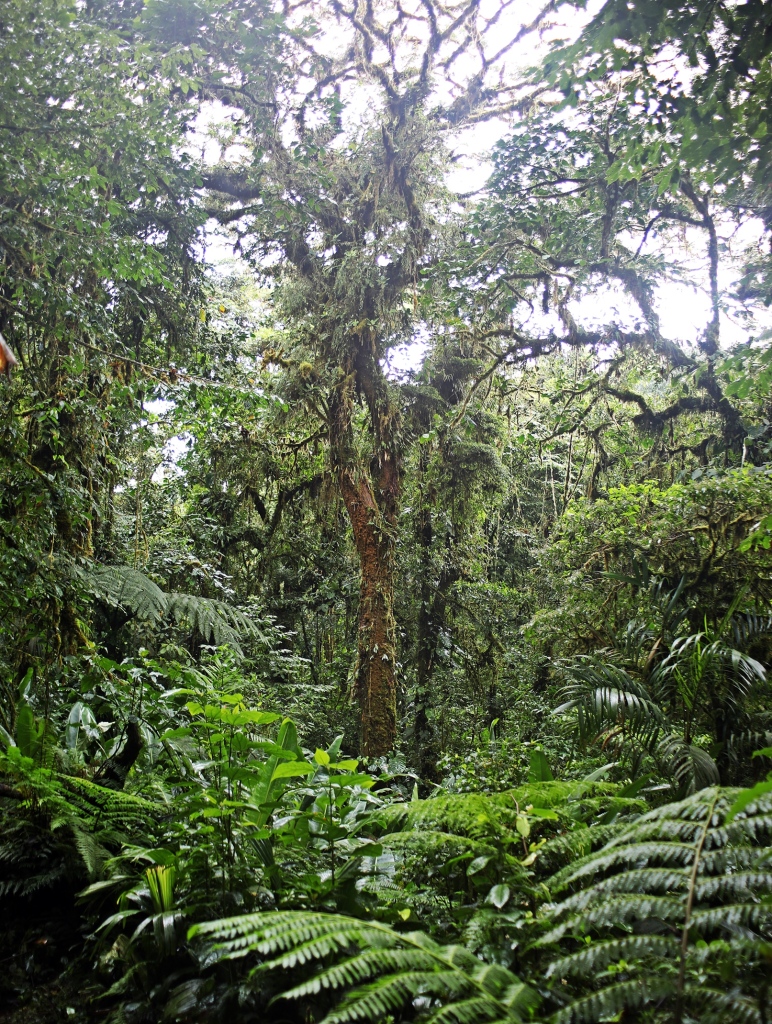
Dense vegetation, Santa Elena Cloud Forest Reserve 
Dense vegetation, Santa Elena Cloud Forest Reserve 
Mossy bench, Santa Elena Cloud Forest Reserve 
View from lookout, Santa Elena Cloud Forest Reserve
In addition to the lush green vegetation, there were colourful flowers including False Birds of Paradise, bright Passion flowers and many other unusual ones. Some flowers were growing directly on the tree bark.

False Bird of Paradise flower, Santa Elena Cloud Forest Reserve 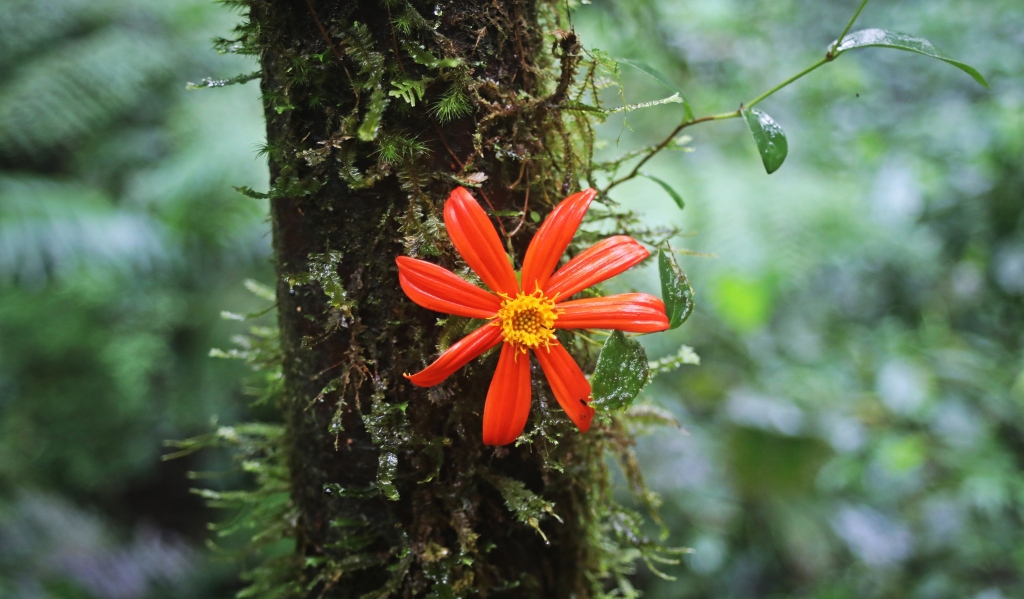
Jungle flower growing on a tree, Santa Elena Cloud Forest Reserve 
Passion flower, Santa Elena Cloud Forest Reserve 
Jungle flower, Santa Elena Cloud Forest Reserve 
The day began cloudy as you would expect, but part way into hiking the longest loop it began to rain and then pour. When it rains, which is most of the time, this natural trail is one big mud puddle. There were places where wooden steppingstones were placed to help, but instead they acted like hovercrafts over the wet mud, giving us an unexpected ride.

Hiking trail, Santa Elena Cloud Forest Reserve 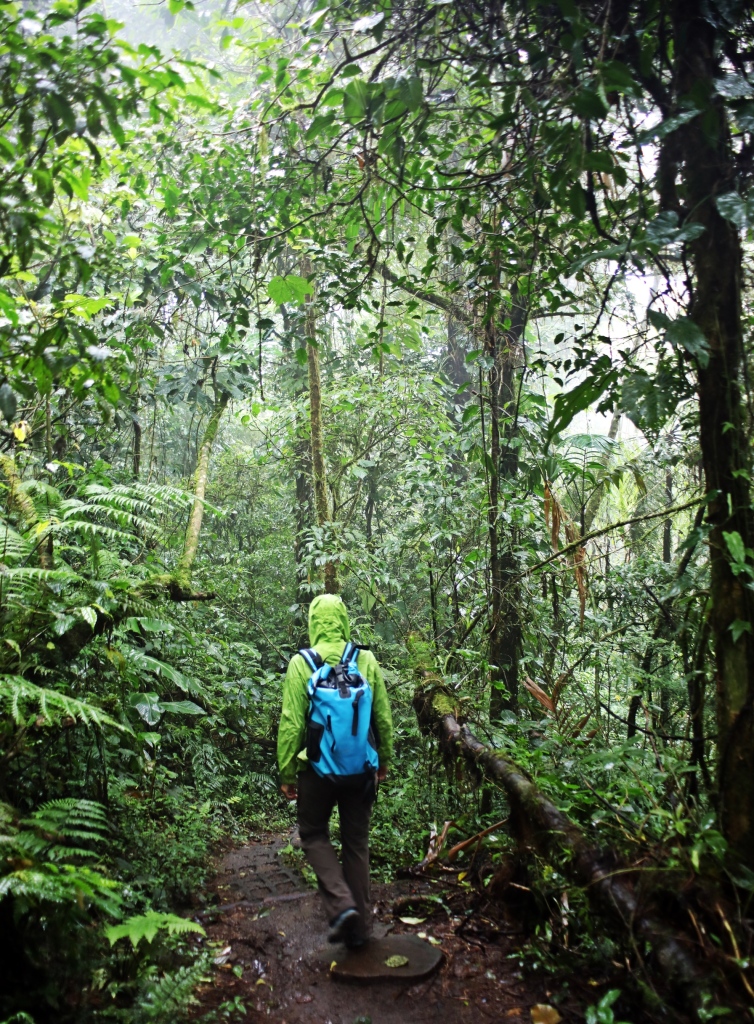
Stepping stone on hiking trail, Santa Elena Cloud Forest Reserve
There are many animals in the cloud forests, but we all we saw was one caterpillar. Animals are not easy to spot because they hide from the rain under the dense foliage.
By the end of the hike we were soaked, covered in mud and shivering from the cold. It was good to visit a cloud forest, to see a very dense jungle, but it’s very messy. It will probably be our last cloud forest.

Caterpillar, Santa Elena Cloud Forest Reserve
Santa Elena
Santa Elena is a cute mountain town with nice shops and restaurants. The sky was usually clear but there were always clouds hovering over the mountain tops above. It was very windy when we were there. Most days these strong winds blew moisture from the cloud forests resulting in horizontal rain in town. Toward the ocean, the sky is usually clear and there are terrific views of the Pacific coast.
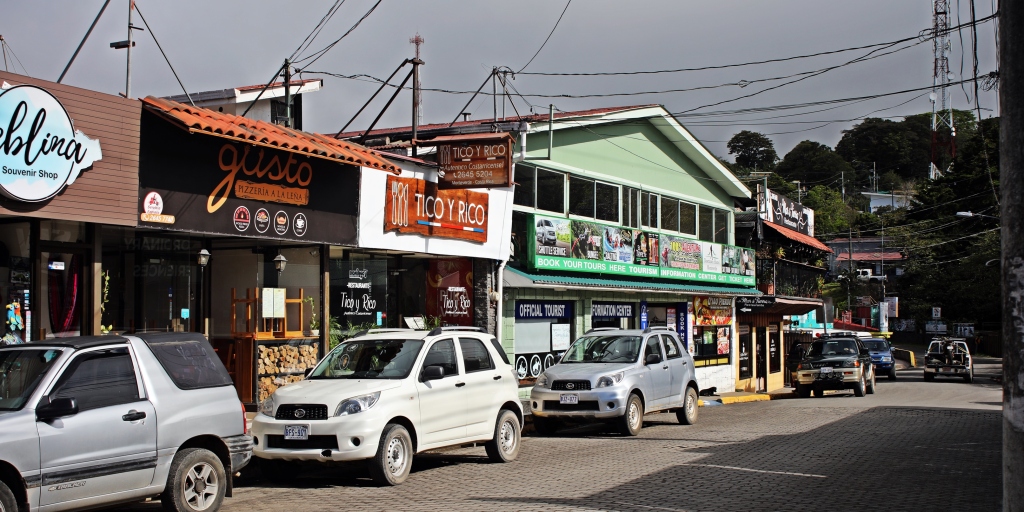
Santa Elena 
View of Pacific coast from Santa Elena 
Capuchin Monkeys, Santa Elena 
Capuchin Monkey, Santa Elena
Monteverde Butterfly Gardens
There are over 1,200 species of butterflies in Costa Rica. Ten percent of the butterfly species in the world are found in this small country. To compare, there are 750 species in all the US and only 350 in Canada. Monteverde Butterfly Gardens was one of the first butterfly farms in Costa Rica. They have 3 greenhouses simulating the three different climates in Costa Rica. As you walk from greenhouse to greenhouse you can see the different plants and butterflies from each zone. Entry fee includes a guided tour of the site by very enthusiastic guides. We learned a lot about butterflies and why they have different characteristics in different zones. Some taste good to predators so they hide using camouflage techniques. Others are toxic. Predators have learned to avoid these ones so the butterflies can be bright and colourful. Taking advantage of this, some good tasting ones mimic the look of toxic ones.
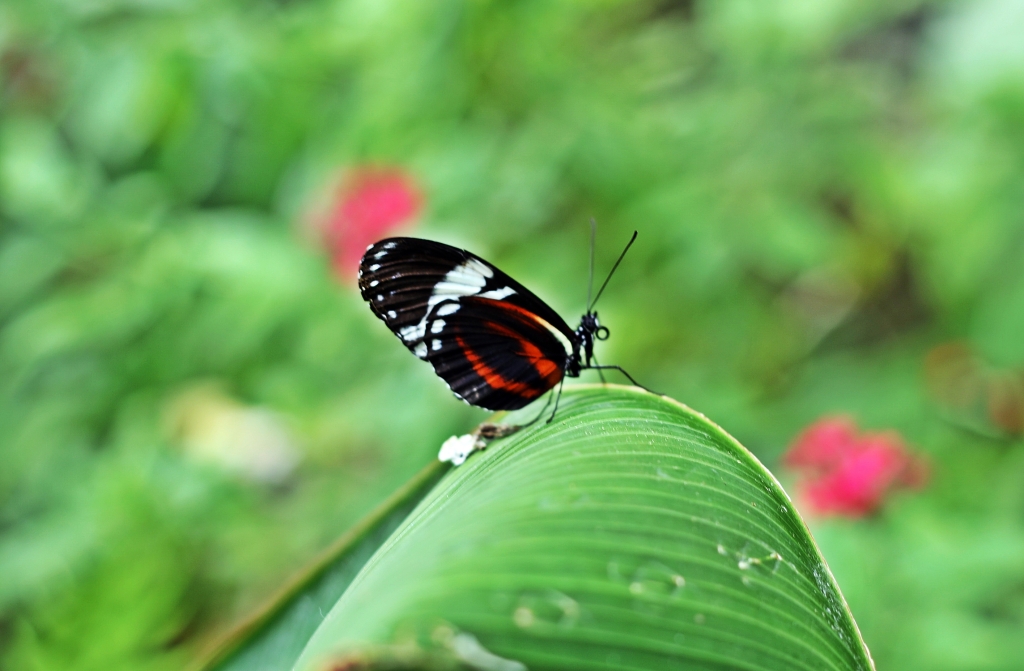
Butterfly, Monteverde Butterfly Gardens 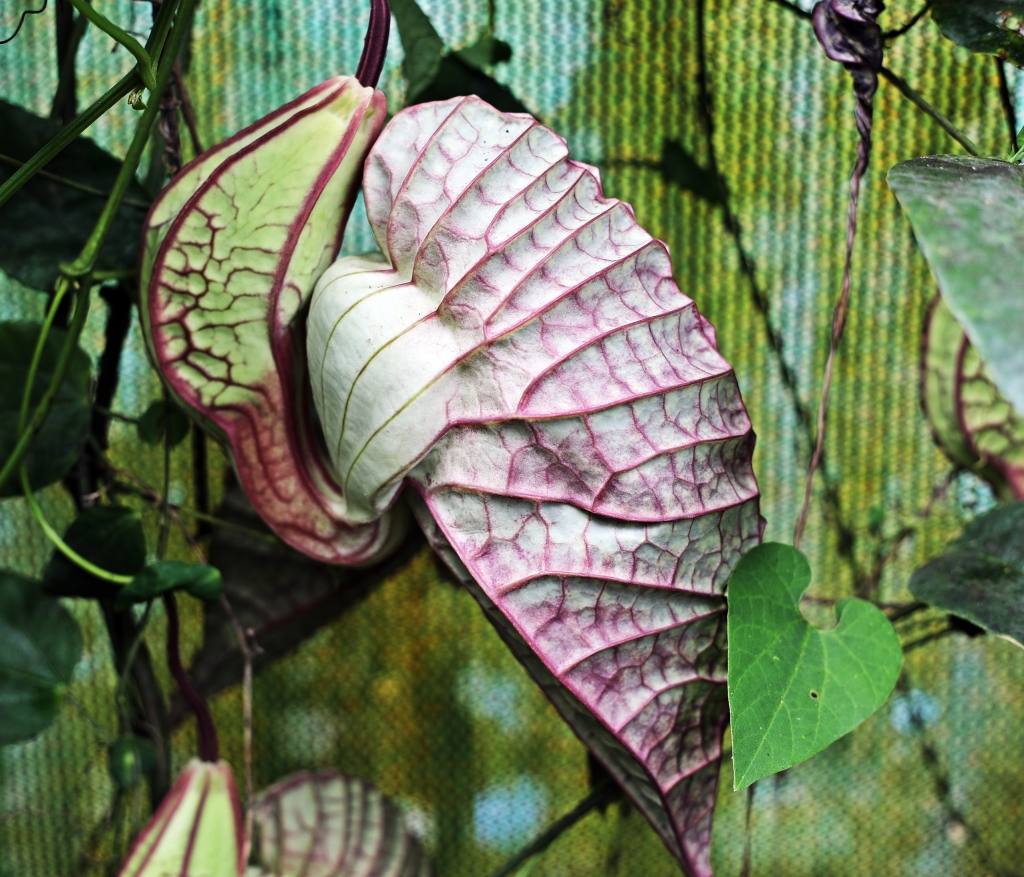
Carnivorous flower, Monteverde Butterfly Gardens 
Butterfly, Monteverde Butterfly Gardens 
Flower, Monteverde Butterfly Gardens 
Butterfly, Monteverde Butterfly Gardens 
Butterfly camouflaged as a leaf Monteverde Butterfly Gardens 
Flower, Monteverde Butterfly Gardens 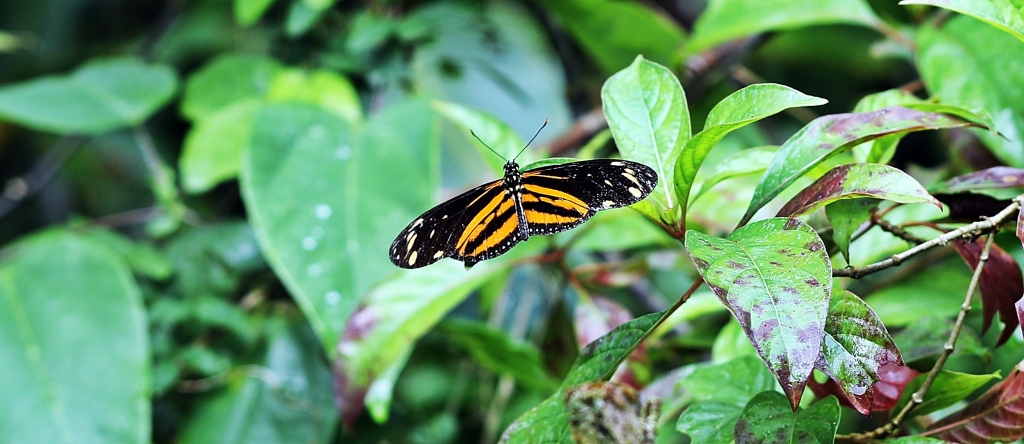
Butterfly, Monteverde Butterfly Gardens 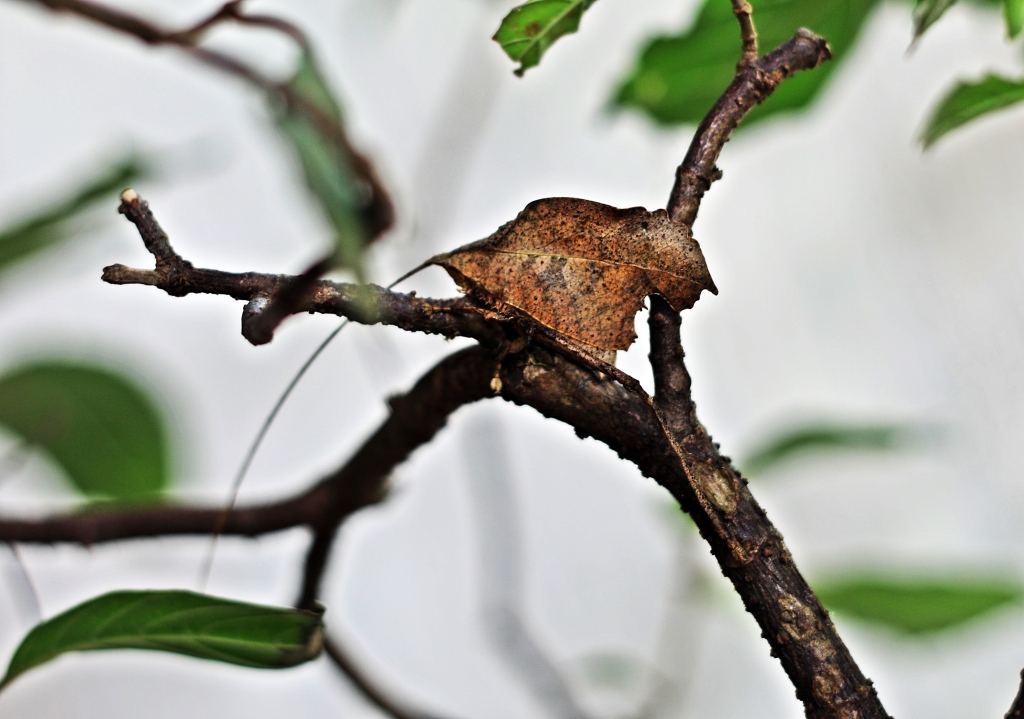
Butterfly camouflaged as a leaf, Monteverde Butterfly Gardens 
Butterfly, Monteverde Butterfly Gardens 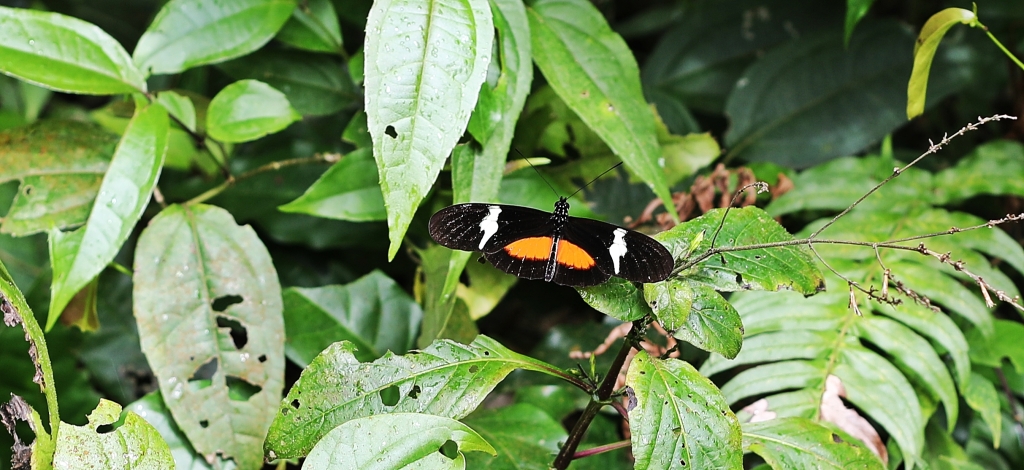
Butterfly, Monteverde Butterfly Gardens 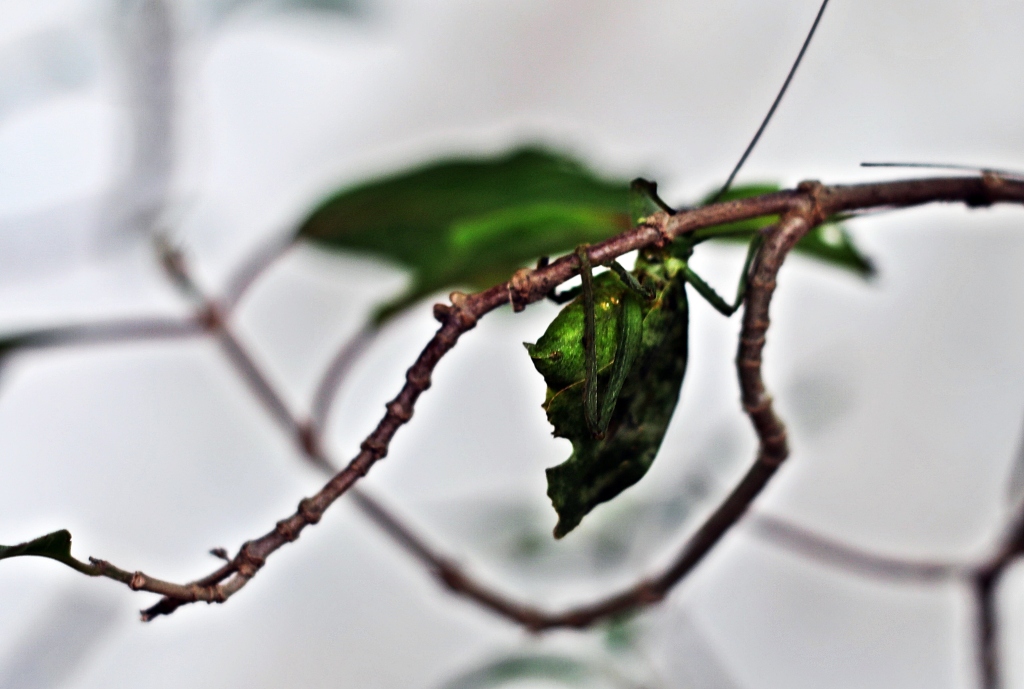
Butterfly camouflaged as a leaf, Monteverde Butterfly Gardens 
Two stage of butterfly larve, Monteverde Butterfly Gardens 
Butterfly caterpillar, Monteverde Butterfly Gardens
A few of our favourites were the blue morpho, owl and postman butterflies. The blue morpho is deceptive. The underside of its wings are plain brown with many eyes. When it flies you get quick glimpses of the stunning iridescent blue on the top of its wings. We saw these butterflies in a few places in Costa Rica. They have an erratic flying pattern and rarely stop so getting good pictures was difficult. We would watch in awe as their beautiful blue wings fluttered past. Owl butterflies are the largest butterflies in Costa Rica at a length 20 cm. Their predators think they are owls because of the owl eyes on their wings. The postman butterfly received its name because it visits the same flowers in the same order every day.

Blue Morpho butterfly, Monteverde Butterfly Gardens 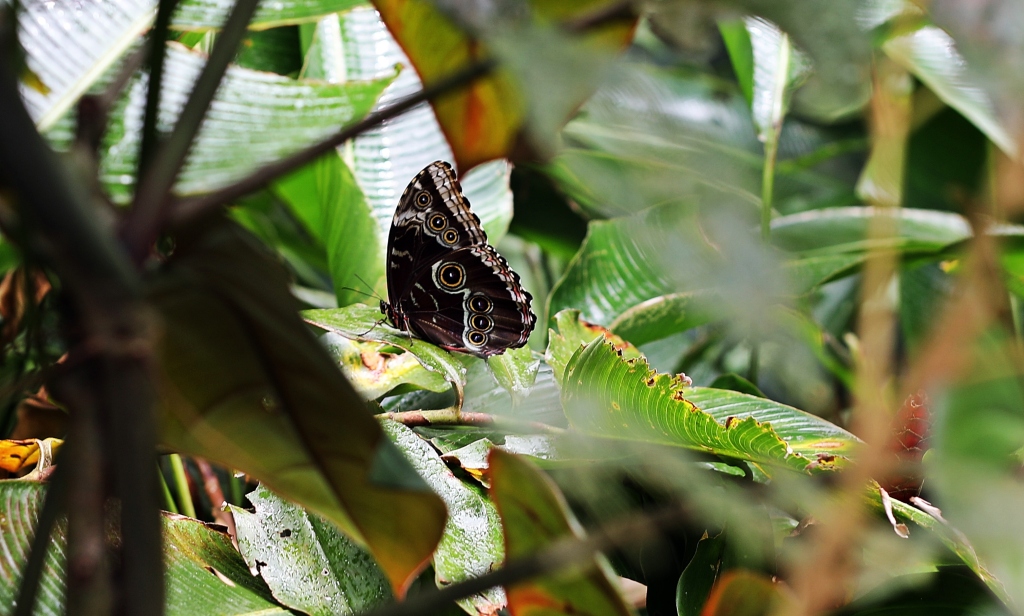
Blue Morpho, Monteverde Butterfly Gardens 
Blue Morpho Butterfly, sourced from internet 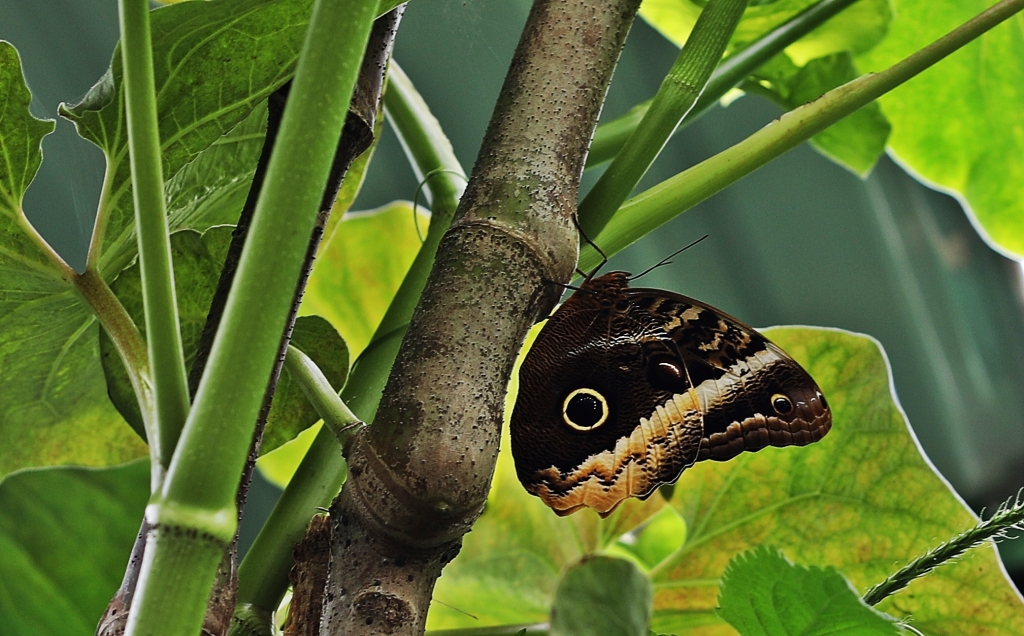
Owl butterfly, Monteverde Butterfly Gardens 
Postman butterfly, Monteverde Butterfly Gardens
Not only do they have butterflies at the gardens, they also have a few interesting insects. There are leaf cutter ants; stick bugs; a tarantula that cleans out its nest every day to keep out ants; and a scorpion that gives birth to 40 babies at one time. She eats the ones that don’t obey her orders.

Leaf cutter ants, Monteverde Butterfly Gardens 
Stick bug, Monteverde Butterfly Gardens
Click for information on Santa Elena/Monteverde
La Fortuna
On the Caribbean side of the mountains, is the popular mountain community of La Fortuna. It’s at the base of Arenal Volcano and is known for its many mountain activities. We visited in February, which is supposed to be the dry season, but it had been raining there for weeks. Before we left for La Fortuna, we met a couple who were recently there. They said in the 2 days they visited, it rained for 2 ½! We decided to go anyway, but as it turned out we only had one morning without rain. It’s not much fun visiting a waterfall or hiking up a volcano in the rain. We did go for a short walk in town visiting Iglesia de La Fortuna de San Carlos and its lovely garden. There is supposed to be a great view Volcan Arena behind it, but all we saw were clouds.
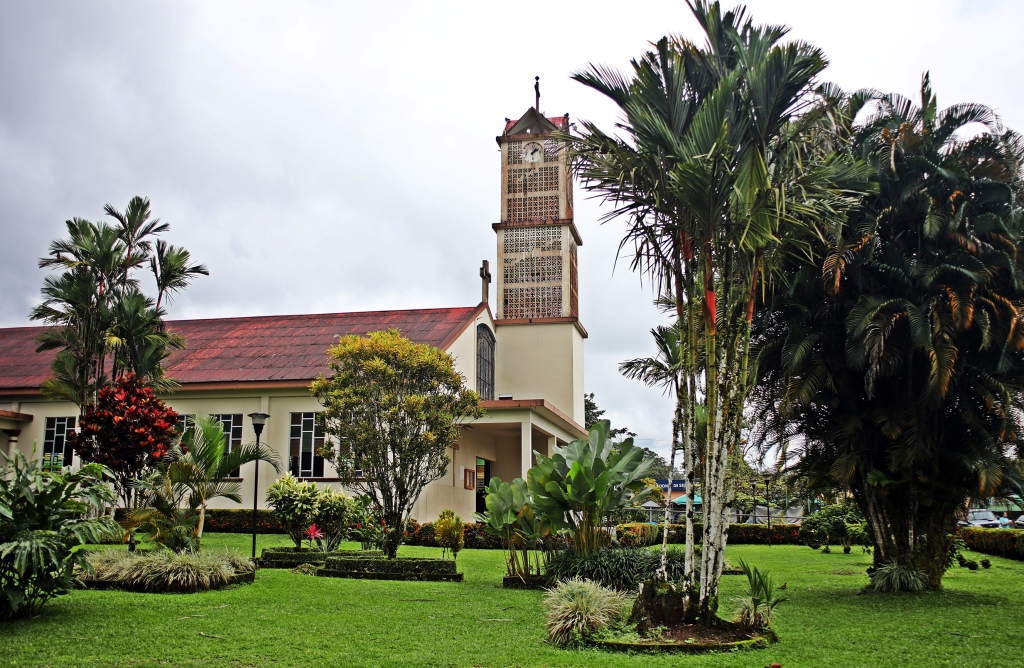
Iglesia de La Fortuna de San Carlos, Costa Rica 
Iglesia de La Fortuna de San Carlos 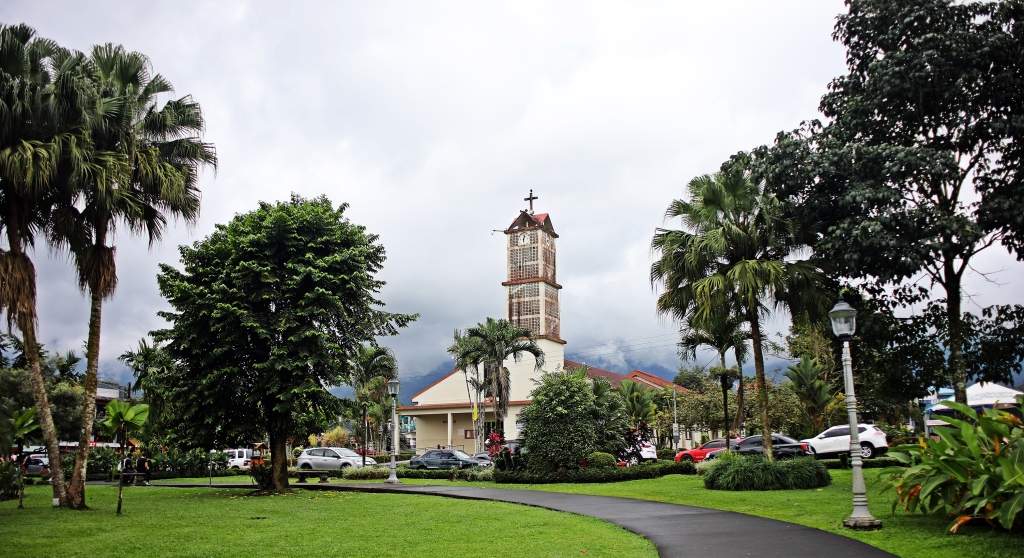
Volcan Arena behind Iglesia de La Fortuna de San Carlos
We walked along a road toward Arena Volcano for an hour before it began to rain again. Its a pretty area with papaya and apple orchards and small farms. We saw many birds including a toucan, but we never saw the volcano.
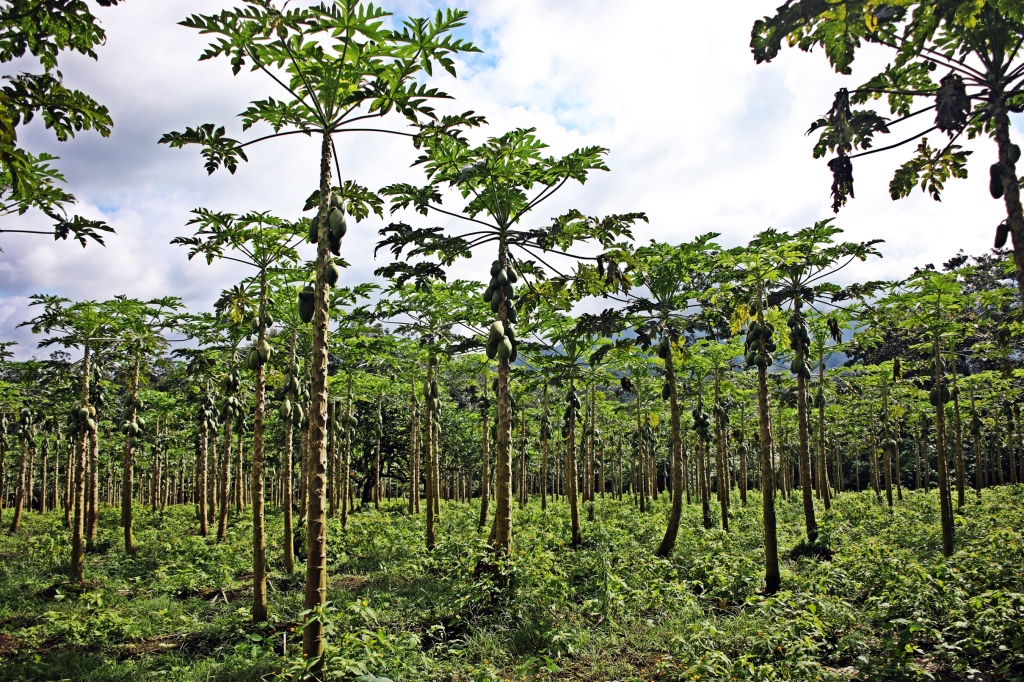
Papaya plantation, La Fortuna 
Papaya plantation, La Fortuna 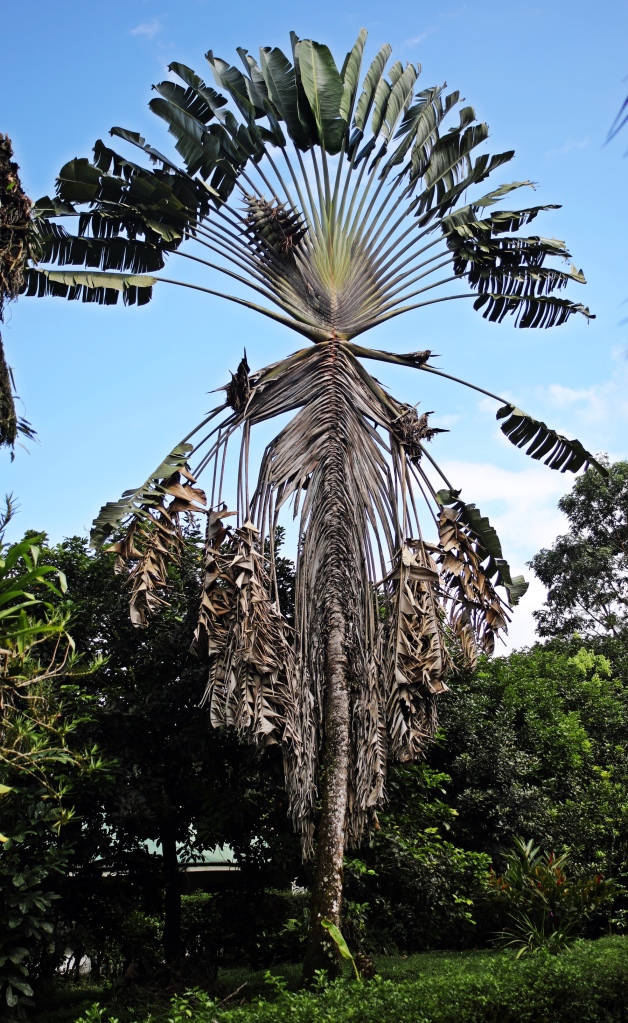
interesting palm, La Fortuna 
View of Volcan Arenal, La Fortuna 
View of Volcan Arenal and mountains, La Fortuna
Click for information on La Fortuna
San Jose
The capital of Costa Rica is not a common tourist stop, but we thought we’d see what it has to offer. We found lovely colonial buildings, parks, museums and a long pedestrian mall. Most of the colonial buildings are scattered through the busy downtown as there is no typical Old Town.
San Jose has many parks within walking distance of downtown. They are small, but have lovely sculptures, park benches and walking paths. Admittedly, there isn’t much for tourists in San Jose, but we were able to fill a day with sightseeing.

Colonial building,San Jose 
National Museum, San Jose 
Buskers on Avenida Central Pedestrian Mall , San Jose 
Avenida Central Pedestrian Mall, San Jose 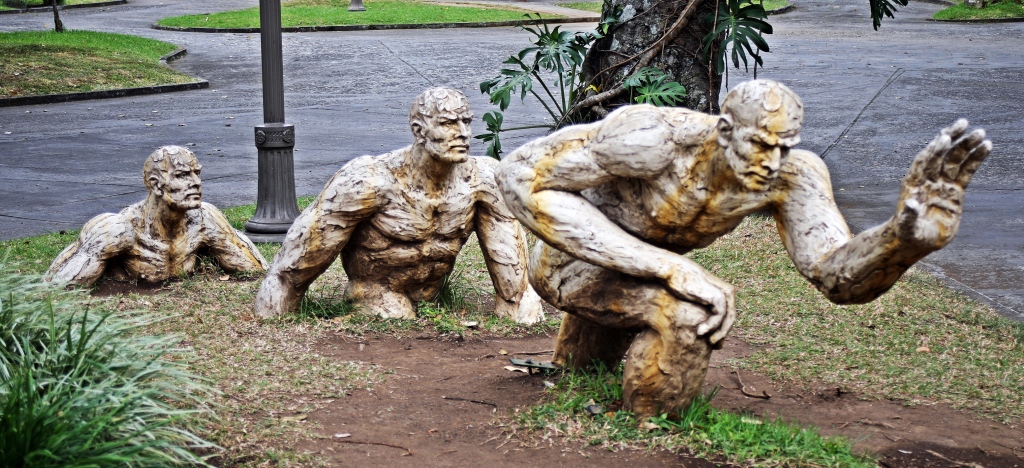
Statues in National Park, San Jose 
National Monument, San Jose
Getting to Santa Elena/Monteverde
By car – Santa Elena is accessed from the TransAmerican Hwy just north of Puntarenas. The road is a winding mountain road, but was in good condition.
By bus
To/from San Jose – There are two buses daily between San Jose and Santa Elena. Leaving from bus Terminal 7-10 in San Jose and Trans Monteverde bus depot in the middle of Santa Elena. Cost is 3000 colones and it takes 4 ½ hours.
To/from Puntarenas – There are 3 buses daily between Puntarenas and Santa Elena. The bus stop in Puntarenas is not marked, but taxis know where it is. The cost is 1600 colones and it takes 3 hours.
Getting to/from other destinations by bus is possible but a bit more complicated as you will need multiple buses. With a little planning it’s not as difficult as it sounds.
To/From La Fortuna – In Santa Elena, take a bus to Puntarenas and then another to Tilaran and then a third bus to La Fortuna. Another option is to take a jeep/boat/jeep combination. Tickets for these can be purchased from travel agents in both town.
To/from Liberia/Tamarindo area beaches etc – In Santa Elena either take a bus to Puntarenas and then to Liberia or Tamarindo or get off on the InterAmerican Hwy and flag down a bus going to Liberia or Canas and then catch another bus to your stop. If getting off on the highway it’s better to take the bus to Puntarenas that travels via Rio Lagarto. The bus driver will know where to drop you off.
We used the website https://centrocoasting.com/ . The information is current, accurate and very helpful.
Visiting the cloud forests
Getting to the cloud forests – Both cloud forest are a few kilometers out of town. There are buses from Santa Elena town to both Monteverde Cloud Forest and Santa Elena Cloud Forest. Buses cost $2 per person each way and can be arranged through your hotel.
Santa Elena Cloud Forest Reserve
Entrance – $16 USD for foreigners
Hours -7 am to 4 pm
Hiking trails – The trails range from ½ km to 5 km and are natural.
Monteverde Cloud Forest Biological Reserve
Entrance – $25 for foreigners
Hours – 7 am to 4 pm
Hiking trails – 11 paved trails ranging from 305 m to 2 km.
Getting to La Fortuna
By car – La Fortuna is located on Hwy 42. The roads are in good condition so would be an easy drive from San Jose, but a long day from Liberia or Monteverde.
To/from San Jose – In February 2020 there was only one direct bus per day between San Jose and La Fortuna. It leaves from bus Terminal 7-10 in San Jose and the bus terminal in La Fortuna. Another option is to take one of the many buses to Ciudad Quesada where you can catch a connector to either San Jose or La Fortuna.
To/From Liberia/Tamarindo etc – This is a long day so take the earliest bus from Liberia to Canas (there is one bus from Tamarindo passing through Canas), then take a bus to Tilaran and then one to La Fortuna.
To/from Santa Elena – see above
Coming Next: Which Costa Rican Beach is for me?
For extra pictures from Costa Rica click here. For pictures from our other blogs go to Gallery at monkeystale.ca
To read about more of our adventures go to Destinations.
If you like what you read, please comment or share (with credit) using the links below.
Another really enjoyable read – great detail and wonderful photos!! You folk have some truly great travels!
LikeLiked by 1 person
You beautifully captured the essence of the cloud forest. Very detailed and informative post. I am sure it looks gorgeous but trails on such paths are bit difficult. But you have made it sound so beautiful. Thank you for sharing! 🙂
LikeLiked by 2 people
Thank you so much. It really is a beautiful jungle because of all of the moisture. Unfortunately that moisture makes for a difficult visit. Thank you for reading.
LikeLiked by 1 person
Wonderful pictures!!!! 🙂 Love the butterfly pictures, the monkeys and the interesting palm tree!! 🙂
LikeLiked by 1 person
Thanks Stephanie, the butterfly gardens were more interesting than I thought!
LikeLiked by 1 person
The Butterfly Gardens must have been amazing! Tropical areas do have so much to offer.. thank you for the tour🙂
LikeLiked by 1 person
Thanks for reading Christie. The butterfly gardens were awesome. I didn’t know what to expect, but there were so many different kinds and some we’d never see in the wild.
LikeLiked by 1 person
Postman butterfly – how neat is that!
LikeLiked by 2 people
I know! I thought it was so funny!
LikeLike
When I read your account about the Blue Morpho a bunch of wonderful Costa Rican memories came back to me. I remember the butterfly gardens, and our son, just little at the time, was totally captivated. Too bad about the rain at La Fortuna/Arenal! Great photos…stick bug is awesome.
LikeLiked by 2 people
Aren’t those butterflies amazing! The first time we saw one I thought I was seeing things. I took a video but it didn’t work out, they’re too unpredictable.
LikeLike
A beautiful country! Thanks for sharing.
LikeLiked by 1 person
Another lovely, descriptive post filled with beautiful pictures. Haven’t had much time for anything lately, but I’m glad I took the time to read this. Thanks for sharing!
LikeLiked by 2 people
Thank you for your kind words. I appreciate you spending your valuable time with us.
LikeLike
It may have been muddy and wet, but I’ll be that cloud forest hike smelled great. I could almost smell the lushness as I was reading about it! (I crave that smell of plant life in the late winter dreariness that is my environment right now.)
LikeLiked by 1 person
Fascinating post with great photos, as ever with you guys. We could almost smell and feel the dampness as we read through!
LikeLiked by 2 people
I always enjoy your informative descriptions so well accompanied by stunning photos. You make me want to travel more.
LikeLiked by 2 people
Thanks you, that’s our goal!! Thanks for reading and for your kind words!
LikeLike
Wonderful and strange. Many of the flowers and insects are the identical to the ones we have in the rain forests of eastern India. I could recognize many of the species. Strange. I thought these two parts of the world have been out of geological contact for over a 100 million years. Either humans have been very diligent in keeping the planet’s ecologies open to each other, or some of these species are more ancient than I realized.
LikeLiked by 1 person
That is very interesting. I think a few species of trees were introduced in colonial days but I don’t think they were rain forest trees. Nature is fascinating.
LikeLiked by 1 person
I appreciate all the information given here. The photos are fabulous!! There is so very much in Costa Rica I did not get to see, in part because I began symptoms of E.Coli on day 3 (of 10), I think. Something nuts happens to me every time I try to experience paradise. I’ll enjoy it through your photos : )
LikeLiked by 1 person
Oh no, how awful. Costa Rica is such an interesting place with a lot of diversity in a small country. Hopefully you get to go there again one day.
LikeLiked by 1 person
It was bad. Yes, I was impressed with the bit that I saw. Met a beach bum named Loco Coco. He made amazing roses & hats from palm leaves! I have the rose he made for me. I think he got an Imperial cerveza as a result : ) Thanks, that may be real nice.
LikeLiked by 1 person
Great photos! Costa Rica is wonderful. Thanks for the trip down memory lane. -Rebecca
LikeLiked by 1 person
Thank you Rebecca, Costa Rica has quite a few beautiful areas. Thanks for reading! Maggie
LikeLiked by 1 person
I loved it there when I went; tropical rain forests, volcanoes, beaches!
LikeLiked by 1 person
What a great post! The cloud forest really got my attention. Very lush and kind of other-worldly, I’d go there in a minute. Excellent photos.
LikeLiked by 1 person
Thank you, it’s a different jungle than we’d ever seen. Bring your rain jacket!
LikeLike
You guys get around. I’ve been to Costa Rica a couple times, but just this series suggests you’ve seen a lot more than I have.
LikeLiked by 1 person
We spent our time exploring a lot of the country. I guess we’re not good at staying in one place. When you go again Monteverde region is worth a visit, but bring your rain jacket! Maggie
LikeLiked by 1 person
Beautiful post and amazing pics.
It made me dream….
LikeLiked by 1 person
Thank you so much, it’s a beautiful mystical place. Dream on!!
LikeLiked by 1 person
💙🙏💙🙏💙
LikeLike
We visited Costa Rica in 1988 and we loved it. I can see that it is still a very nice place and hasn’t gone too overrun by tourists. Nice post. (Suzanne)
LikeLiked by 1 person
Thanks Suzanne, parts of Costa Rca are definitely over run by tourists, but there are still many untouched spots. Thanks for reading, Maggie
LikeLike
Fantastic photos! I loved my visit to Costa Rica and the cloud forest, La Fortuna, and Manuel Antonio. We even did an evening walk at the Children’s Eternal Rainforest for a different experience. Definitely a place I’d go back to! Stay safe!
LikeLiked by 1 person
Thank you Linda, Costa Rica is an amazing country. I’m sure we’ll return some day.
LikeLiked by 1 person
Stunning! I couldn’t get over the blue butterfly. What an experience!
LikeLiked by 1 person
That butterfly is one of the most beautiful living things we’ve ever seen. They’re in many places in Costa Rica, but never rest so are difficult to get a picture. Thanks for reading!
LikeLiked by 1 person
Loved Costa Rica…we even did a night tour of the Eternal Children’s Rainforest in the Monteverde area. We managed to see Arenal Volcano while we stayed in La Fortuna, but it was still a bit hazy. ahhhhhh makes me want to go back. So much beauty in such a small country. 🙂
LikeLiked by 1 person
Glad you had better weather than us! It does have such amazing and diverse landscapes in a small area. Thanks for reading!
LikeLiked by 1 person
Love to visit cloud forest one day in south America.
LikeLiked by 1 person
It was really fun, with more vegetation than you could imagine, but it is very wet. Thanks for reading!
LikeLike
I always love the rainforest with its diversed ecosystem. The cloud forest is even cooler with the misty weather and richer plant life.
All the best to you.
LikeLiked by 1 person